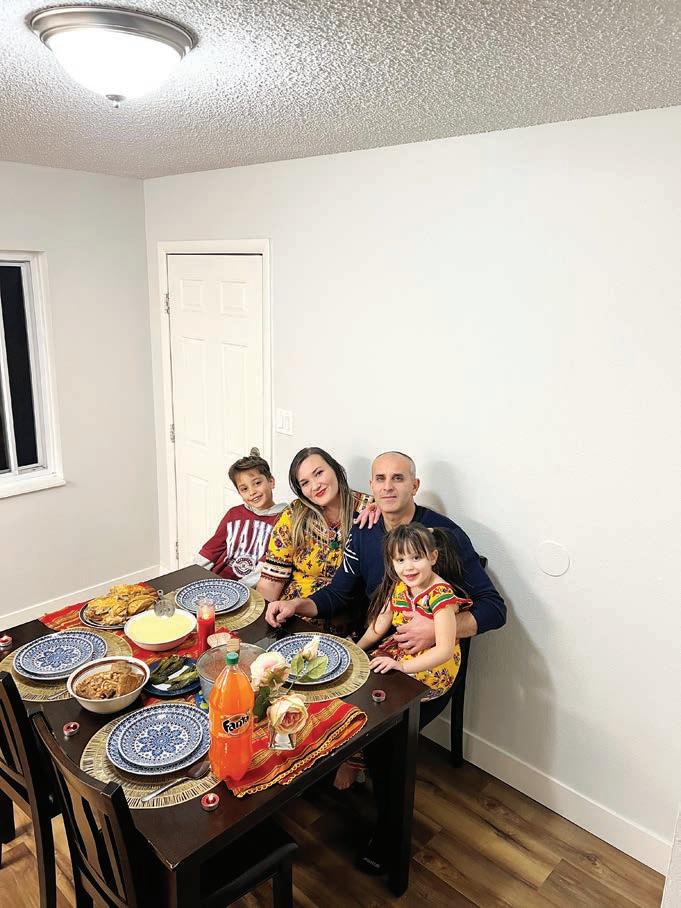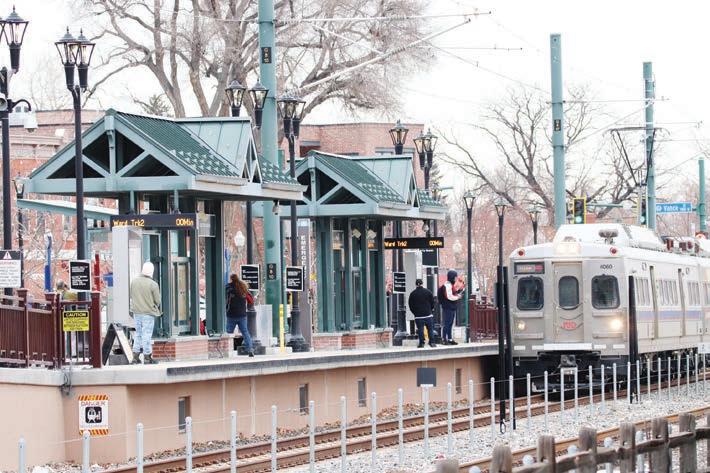
9 minute read
Cities where six-figure salaries can’t buy homes
BY MCKENNA HARFORD MHARFORD@COLORADOCOMMUNITYMEDIA.COM
Aldjia Oudachene’s Littleton home is “a wish come true.” e house is close to the school bus stop, near work and even has a guest room where Oudachene’s father stays when he visits.
“We have good neighbors who have children the same age, so they play together and I’m so happy here,” Oudachene said.
Originally from Tizi Ouzou, Algeria, Oudachene, her husband and two children moved to Littleton in October 2020. In Algeria, Oudachene’s family lived in a house they could a ord on her and her husband’s incomes as French teachers. When they moved to Littleton, Oudachene said it was a challenge.
“When we came here, we started our life from nothing,” she said. “Here, to teach French, I have to learn English rst.”
To make ends meet, Oudachene and her husband took full-time positions with Walmart, but, even then, the high cost of housing put homeownership outside of their budget. Instead, they rented a two-bedroom apartment.
“With the apartment, life was stressful for us,” she said. “ ere wasn’t a lot of space and no place for (the children) to play.” e application process took about a year, but Oudachene said there was no way her family would have a house without Habitat for Humanity Metro Denver’s help. In the end, the organization provided an opportunity for the family to invest in a home within their budget.
Oudachene’s family needed more space and privacy. So they kept looking for a house. Oudachene said her family friend told her about Habitat for Humanity. e national nonpro t vision is a “world where everyone has a decent place to live.” And a ordability is a major part of the organization’s vision.
“We would have had to wait to have the budget without Habitat,” she said. “It was so fast. Now, I’m happy to pay the mortgage because it goes into our home.”
From 2017 to 2022, the average home price in Littleton has gone up $300,000, but the city is not alone. Over the same period, Brighton saw home prices increase $225,000, Arvada saw a $275,000 increase and Lone Tree homes are up more than $470,000 on average.
As nding a ordable housing becomes harder for a growing number of Colorado families, municipalities and nonpro ts are looking to expand existing solutions like inclusionary zoning, community land trusts and deed restrictions.
Communities that have implemented one or more of these approaches report increasing their a ordable housing stock, though ofcials emphasized that the complexity of Colorado’s housing situation means there is no silver bullet.
However, across the board, a key element to getting support for the expansion of a ordable housing programs is changing the mindset of who bene ts from them. Supply, but for whom? e ones feeling the crunch the most are those who earn the least money, though many of those struggling to a ord housing have aboveaverage salaries.
Another impact of rising housing costs throughout the metro area, many communities are reaching a critical point where a majority of workers can’t a ord to live where they’re employed.
Corey Reitz, the executive director for South Metro Housing Options, an a ordable housing provider that serves Littleton and Arapahoe County, said housing prices are now una ordable even for people who take home a solid paycheck. at includes earners topping $82,000, the median household income in Adams, Arapahoe, Douglas and Jefferson counties, according to data from the Colorado Housing and Finance Authority.
“In the past there was an a ordability issue around those lower (area median incomes), but we’re to a point right now where a ordability impacts so many people across a larger spectrum,” Reitz said.
Across the state, the share of housing a ordable to Coloradans has dropped signi cantly. In 2021, just 51% of the state’s housing stock was a ordable for median income earners. at’s down from 76% in 2015, according to research from the Colorado Futures Center, a nonpartisan research group out of Colorado State University.
Phyllis Resnick and Jennifer Newcomer, the authors of the study, said they believe the continuous rise in pricing, even as the housing supply grows, indicates a mismatch in the kind of housing needed and the kind of housing being built.
“ ere’s supply, but supply for who? At what monetary level?” Newcomer asked.


It looks like this: subdivisions of four- and ve-bedroom homes, handfuls of luxury apartments and few, if any, condos and starter homes.
“ e thing that we’re trying to gure out how to illuminate most speci cally is this nuanced distinction between total rooftops and this notion of supply with respect to availability,” Newcomer said.
Resnick said the current market doesn’t incentivize the construction of lower-cost housing. Per her 2021 analysis, housing values in Colorado would need to drop by roughly onethird to return to the 2015 levels of a ordability – something unlikely to happen, experts have told Colorado Community Media throughout our four-week housing series.
“I suspect when we nish our research, we’re going to nd that housing that is a ordable to people who are closer to the economic margins is sort of not feasible in the sense of being pro table for the folks who need to be out there building that housing,” Resnick said.
A Golden gap
Without the market providing entry-level housing or starter homes, nonpro ts and local governments have stepped in to try to ll the gap by subsidizing building and buying costs.
An extreme example is the city of Golden, where 95% of its workforce lives outside city limits.
Just this month, the city applied for a grant to support a $65 million partnership with Habitat for Humanity to construct 120 for-sale condos and townhomes for residents making 80% of the area median income for households. at’s roughly $65,000 for an individual and around $93,000 for a family of four.
Golden recently completed a housing needs assessment in October, which found that both housing prices and rent increased exponentially in less than a decade. e cost of the average house in the city doubled between 2015 and 2022. For the rst half of 2022, the average single-family home sold for $1 million, up from $533,000 in 2015. is means even relatively highincome earners in Golden are considered by the city to be burdened by housing costs.
“ e majority of the housing that we’re projected to need in the next 10 years will need to serve households at or above 120% area median income,” Golden Housing Coordinator Janet Maccubbin said. “So you’re looking at households that would make well into six gures and yet there’s not housing that exists for them in Golden.”
Maccubbin said the newly formed A ordable Housing Committee is expected to meet in February and will begin to shape the city’s response and goals for addressing housing needs.
Land and options
Habitat for Humanity Metro Denver’s approach to providing a ordable housing is to tackle two of the most expensive elements of housing — land and labor.
CEO Heather La erty said the organization, which works in Adams, Arapahoe, Denver, Douglas and Je erson counties, relies on partnerships with developers, as well as volunteers and program recipients to provide the labor.
To create a ordable housing that stays a ordable into the future, the organization utilizes Colorado Community Land Trust and deed restrictions. Under the land trust model, land is owned by a community trust or nonpro t, so homeowners only pay for the cost of the home.
e trust currently has 215 properties, including townhomes and single-family homes, which serve households at or below 80% median income.
“It used to be that if we could just create an a ordable product, it would be something that would be a ordable in the future, just naturally, and that’s not the case today,” La erty said. “What (the community land trust) does is, then in law in perpetuity, it only allows those homes to be sold to homebuyers in a similar income category. So it provides a ordability initially, but it also ensures 20 years from now it is sold with an income restriction.”
In addition to the trust, Habitat for Humanity Metro Denver also uses deed restrictions to ensure homeowners meet income requirements.
La erty said the models are successful because they provide lower-cost housing, while allowing by the developer increase costs.

Some of those NIMBY arguments cite defense of the environment, Rigler said. e groups cite dense developments as taking up land that would otherwise be used as open space, or that the new housing would attract more tra c, causing more pollution.
New research may counter those stances.
What about water?
When Makarewicz thinks about density and water use, she thinks of leakage from pipes.
“ ere’s a lot of leakage in our water pipes,” she said. “Each time you create those joints and individual pipes and stretch them farther out into undeveloped parts of the county, you’re losing water.” at’s where more e cient technology plays a role. In Westminster, water consumption declined in the past two decades despite an increase in population and commercial use. In fact, Westminster added 15,000 residents to the community and 150 new commercial business accounts.
She also thinks of lawns. Lower density areas usually require more square feet of lawns. With more units, less water is going towards Kentucky bluegrass.
Less density doesn’t always mean less water usage, either. She said it really comes down to per-person usage and how many water-based appliances are in the home.
Senior Water Resources Analyst
fects a large portion of that decline, like newer high-e ciency toilets that use less water than older ones.
e question of how much technology can continue to improve remains, though Sarah Borgers, interim department director of Westminster’s public works and utilities department, thinks there’s much more room to grow.
“Industry-wide, I think the sense is we are not close to there yet. ere’s still a long way to go before we hit that plateau,” she said. “We don’t know what the bottom is, but we aren’t there yet.”

Pro-density ratings are low e majority of Americans are increasingly opposed to the idea of living in dense areas. In fact, about 60% want “houses farther apart, but schools, stores and restaurants are several miles away.” e number of Americans wanting homes “smaller and closer to each other, but schools, stores and restaurants are within walking distance” went from 47% in 2019 to 39% in 2021. e Pew Research Center said the pandemic with increased “telework, remote schooling and pandemicrelated restrictions on indoor dining and other indoor activities.”

Despite attitudes shifting against density, Riger said the region mostly will densify with many municipalities at build-out and reaching their outward boundaries as population increases.
“I think it’s going to be a mix of growing out and growing up,” he said.
With higher density comes transit options, because land use is a transportation strategy.
According to the Colorado Department of Public Health, transportation was the second largest greenhouse gas contributor for the state by sector, losing to electric power as the rst.
With mixed-use, well designed, higher density areas, residents are able to walk more, reduce their travel times and distances, and have the ability to support transit lines and bike lanes.
An example could be seen in Olde Town Arvada.
Housing on transit lines e city prevailed and the new transit oriented development transformed Arvada, Cook said. It created a center that attracts citizens from around the area and which bene ts merchants, restaurants and others.
Since Cook moved into Arvada back in 1983, she’s seen the city transform into something di erent, crediting transit oriented development with bringing life into Arvada’s Olde Town.
Cook, along with several others, teamed up with Forward Arvada, a nonpro t looking to revitalize Olde Town in the 90s. ey tasked themselves with making an idea — to run a train line along decommissioned railroad tracks — into a reality to make sure Olde Town began to thrive.

Eventually, the G Line opened in 2019 and development began to spring up.
It didn’t happen without opposition, though. Residents voiced concerns over sacri cing the historical character of the town. In fact, the city faced lawsuits from a group called All the People regarding approving development plans to add to the transit oriented development, or TOD.
All of that can also be attributed to the mixed-use, higher density design model, where someone can live above a bakery or right next to a co ee shop.
With less emphasis put on cars, which Cook sees as a good thing, residents can live in a place where they can walk to various places. She said it contributes to more of a family feel.
See more on urban sprawl online at coloradocommunitymedia.com/ longwayhome/index.html.
Woman goes from being homeless to an apartment
BY STEVE SMITH SSMITH@COLORADOCOMMUNITYMEDIA.COM
Lisa Hojeboom has a new place to call home.
It’s a one-bedroom apartment near Chat eld Dam complete with a walkout basement, a washing machine and a neighbor’s water feature “that sounds like a babbling brook.”
It’s quite a change. Hojeboom spent a year and a half living in places other than apartments. She lived in her car. She lived in a shelter. She lived at the Northglenn Recreation Center, where she slept on the oor of the gym and could get a 30-minute shower for $4.50.
“ e rst thing I did when I moved in was soak in a hot tub,” she said. “It was so nice.”
She was among many forced out of living arrangements because of the high cost of housing.
“I never pictured myself in that situation,” she said. “I did what I had to do.”
Hojeboom lived with her brother,








